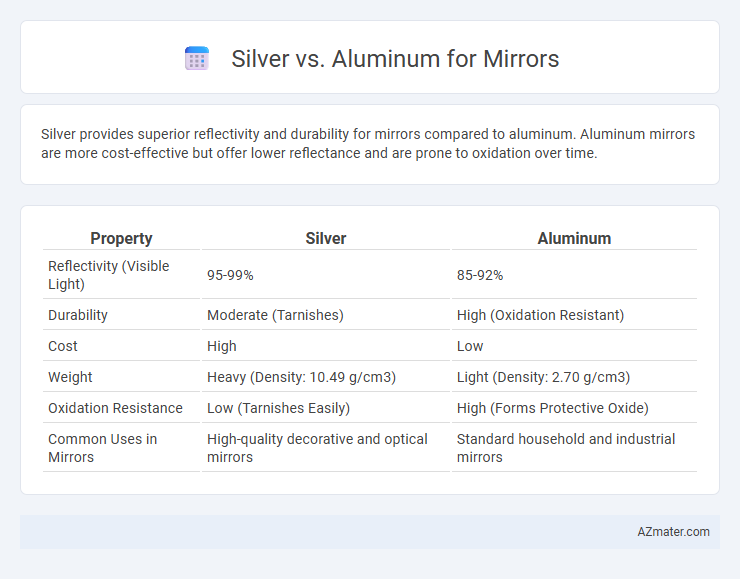Silver provides superior reflectivity and durability for mirrors compared to aluminum. Aluminum mirrors are more cost-effective but offer lower reflectance and are prone to oxidation over time.
Table of Comparison
| Property | Silver | Aluminum |
|---|---|---|
| Reflectivity (Visible Light) | 95-99% | 85-92% |
| Durability | Moderate (Tarnishes) | High (Oxidation Resistant) |
| Cost | High | Low |
| Weight | Heavy (Density: 10.49 g/cm3) | Light (Density: 2.70 g/cm3) |
| Oxidation Resistance | Low (Tarnishes Easily) | High (Forms Protective Oxide) |
| Common Uses in Mirrors | High-quality decorative and optical mirrors | Standard household and industrial mirrors |
Introduction: Silver vs Aluminum Mirrors
Silver mirrors provide superior reflectivity, especially in the visible light spectrum, offering around 95% reflectance, while aluminum mirrors typically reflect about 90%. Silver is more prone to tarnishing due to oxidation, requiring protective coatings, whereas aluminum naturally forms a durable oxide layer that enhances corrosion resistance. The choice between silver and aluminum mirrors depends on the balance between superior optical clarity and longevity in various environmental conditions.
Historical Use of Silver and Aluminum in Mirrors
Silver has been historically favored in mirror-making for its superior reflectivity and durability, dating back to ancient times when silver coatings provided clear, bright reflections. Aluminum emerged as a popular alternative in the 20th century due to its cost-effectiveness, corrosion resistance, and lightweight properties, becoming the standard in modern commercial mirrors. Despite aluminum's practicality, silver-coated mirrors are still prized for high-end applications requiring exceptional reflectance quality and longevity.
Optical Reflectivity Comparison
Silver offers superior optical reflectivity compared to aluminum, with reflectance values exceeding 95% across the visible spectrum, making it ideal for applications requiring high brightness and clarity. Aluminum typically reflects around 85-90% in the visible range but performs better in the ultraviolet region, making it suitable for UV applications. The higher reflectivity of silver enhances image quality in mirrors, reducing light absorption and improving overall visual performance.
Durability and Longevity Analysis
Silver mirrors offer superior reflectivity with a durability that excels when coated with protective layers, providing longevity that can span several decades if properly maintained. Aluminum mirrors, while less reflective, boast enhanced resistance to oxidation and corrosion, making them ideal for outdoor or high-humidity environments, thus extending their functional lifespan under harsh conditions. Choosing between silver and aluminum for mirror applications depends on balancing peak reflectivity and durability needs against environmental exposure factors.
Cost Efficiency and Availability
Silver mirrors offer superior reflectivity and durability but come at a higher cost compared to aluminum, making aluminum a more budget-friendly option for large-scale or commercial projects. Aluminum's abundance and lower production costs ensure wide availability, while silver's expense and limited supply can constrain its use primarily to high-end or specialized applications. Balancing cost efficiency and availability, aluminum is preferred for cost-sensitive projects, whereas silver is chosen when maximum reflectivity and longevity justify the investment.
Corrosion Resistance and Maintenance Needs
Silver mirrors offer superior reflectivity but are more prone to tarnishing and corrosion, requiring regular maintenance with anti-tarnish coatings or protective sealants. Aluminum mirrors provide better corrosion resistance, especially in humid or outdoor environments, with lower maintenance demands due to their naturally forming oxide layer that protects the surface. Choosing between silver and aluminum mirrors depends on the balance between desired optical performance and the environment's exposure to corrosive elements.
Common Applications for Silver and Aluminum Mirrors
Silver mirrors are commonly used in high-end optical instruments and scientific equipment due to their superior reflectivity and excellent performance in the visible spectrum. Aluminum mirrors, preferred for industrial and aerospace applications, offer durability and cost-effectiveness with good reflectivity across ultraviolet to near-infrared wavelengths. Both materials serve essential roles: silver mirrors excel in precision imaging and spectroscopy, whereas aluminum mirrors are favored for rugged environments and broad-spectrum optical systems.
Impact on Image Quality and Clarity
Silver coatings on mirrors provide superior reflectivity across the visible spectrum, resulting in enhanced image brightness and accurate color representation, which significantly improves image quality and clarity. Aluminum mirrors, while more durable and resistant to oxidation, offer slightly lower reflectance, especially in the red and near-infrared wavelengths, potentially reducing image sharpness and contrast. The choice between silver and aluminum coatings directly impacts optical performance, with silver preferred for high-precision applications requiring maximum clarity and aluminum favored for cost-effective, long-lasting solutions.
Environmental and Safety Considerations
Silver-coated mirrors provide superior reflectivity and durability but involve environmental concerns due to mining impacts and chemical usage in silver extraction. Aluminum mirrors offer a more sustainable choice with lower energy consumption and fewer toxic byproducts during production. Safety-wise, aluminum is less prone to degradation and does not pose significant health risks, whereas silver coatings can tarnish and require careful handling of chemicals in manufacturing.
Conclusion: Which is Better for Mirrors?
Silver offers superior reflectivity and a warmer tone, making it ideal for high-quality, luxurious mirrors, while aluminum provides excellent durability and resistance to tarnish at a lower cost. For applications requiring maximum clarity and vivid reflection, silver remains the preferred choice despite its higher maintenance. Aluminum suits more budget-conscious projects where longevity and ease of upkeep are prioritized over optimal reflective performance.

Infographic: Silver vs Aluminum for Mirror
 azmater.com
azmater.com